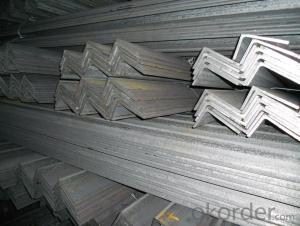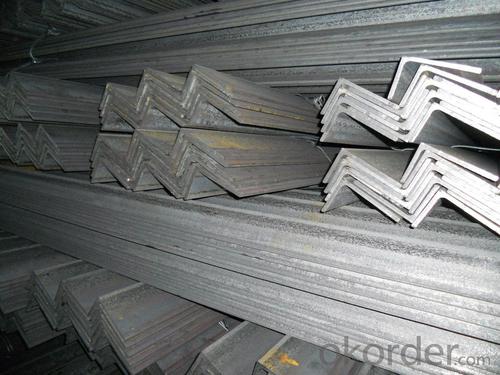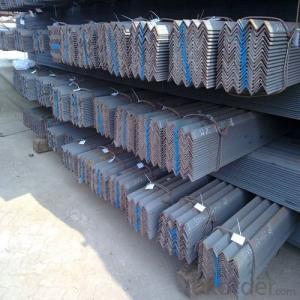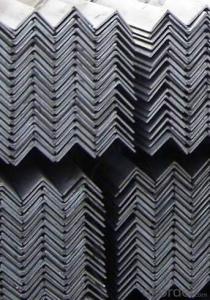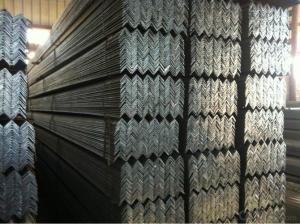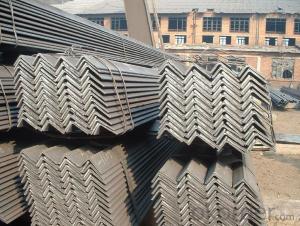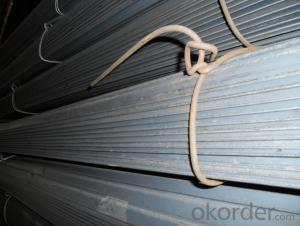Carbon Steel Unequal Angle with High Quality
- Loading Port:
- China Main Port
- Payment Terms:
- TT or LC
- Min Order Qty:
- 100 m.t.
- Supply Capability:
- 10000 m.t./month
OKorder Service Pledge
OKorder Financial Service
You Might Also Like
Product Description:
OKorder is offering Carbon Steel Unequal Angle with High Quality at great prices with worldwide shipping. Our supplier is a world-class manufacturer of steel, with our products utilized the world over. OKorder annually supplies products to African, South American and Asian markets. We provide quotations within 24 hours of receiving an inquiry and guarantee competitive prices.
Product Applications:
Carbon Steel Unequal Angle with High Quality are ideal for structural applications and are widely used in a variety of architectural and engineering structures, such as beams, bridges, ship; transmission tower, reaction tower; lifting transportation machinery; industrial furnace; container frame, warehouse goods shelves, etc
Product Advantages:
OKorder's Carbon Steel Unequal Angle with High Quality are durable, strong, and wide variety of sizes.
Main Product Features:
· Premium quality
· Prompt delivery & seaworthy packing (30 days after receiving deposit)
· Can be recycled and reused
· Mill test certification
· Professional Service
· Competitive pricing
Product Specifications:
Manufacture: Hot rolled
Grade: Q195 – 235
Certificates: ISO, SGS, BV, CIQ
Length: 6m-12m, as per customer request
Packaging: Export packing, nude packing, bundled
| UNEQUAL ANGLE STEEL | |||||
| size(mm) | a(mm) | a1(mm) | thickness(mm) | kg/m | length(m) |
| 75*50*5 | 75 | 50 | 5 | 4.808 | 6m,9m,12m |
| 75*50*6 | 75 | 50 | 6 | 5.699 | 6m,9m,12m |
| 75*50*8 | 75 | 50 | 8 | 7.431 | 6m,9m,12m |
| 100*75*7 | 100 | 75 | 7 | 9.34 | 6m,9m,12m |
| 100*75*8 | 100 | 75 | 8 | 10.6 | 6m,9m,12m |
| 100*75*9 | 100 | 75 | 9 | 11.8 | 6m,9m,12m |
| 100*75*10 | 100 | 75 | 10 | 13 | 6m,9m,12m |
| 100*75*12 | 100 | 75 | 12 | 15.4 | 6m,9m,12m |
| 125*75*7 | 125 | 75 | 7 | 10.7 | 6m,9m,12m |
| 125*75*8 | 125 | 75 | 8 | 12.2 | 6m,9m,12m |
| 125*75*9 | 125 | 75 | 9 | 13.6 | 6m,9m,12m |
| 125*75*10 | 125 | 75 | 10 | 15 | 6m,9m,12m |
| 125*75*12 | 125 | 75 | 12 | 17.8 | 6m,9m,12m |
| 150*90*8 | 150 | 90 | 8 | 14.7 | 6m,9m,12m |
| 150*90*9 | 150 | 90 | 9 | 16.4 | 6m,9m,12m |
| 150*90*10 | 150 | 90 | 10 | 18.2 | 6m,9m,12m |
| 150*90*12 | 150 | 90 | 12 | 21.6 | 6m,9m,12m |
| 200*100*10 | 200 | 100 | 10 | 23 | 6m,9m,12m |
| 200*100*12 | 200 | 100 | 12 | 27.62 | 6m,9m,12m |
| 200*100*15 | 200 | 100 | 15 | 34.04 | 6m,9m,12m |
FAQ:
Q1: what is the difference between actual weight and theoretical weight?
A1: All the section steel has two weights: actual weight and theoretical weight. Actual weight is the weighing out when the product delivered from the mill. Theoretical weight is calculated by pieces. The invoice can be based on each of them as your request.
Q2: How do we guarantee the quality of our products?
A2: We have established an advanced quality management system which conducts strict quality tests at every step, from raw materials to the final product. At the same time, we provide extensive follow-up service assurances as required.
Q3: How soon can we receive the product after purchase?
A3: Within three days of placing an order, we will arrange production. The normal sizes with the normal grade can be produced within one month. The specific shipping date is dependent upon international and government factors, the delivery to international main port about 45-60days.
Images:
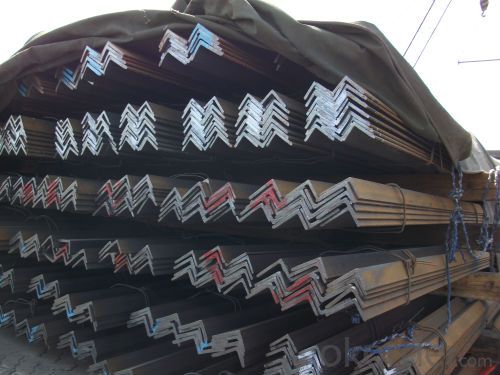
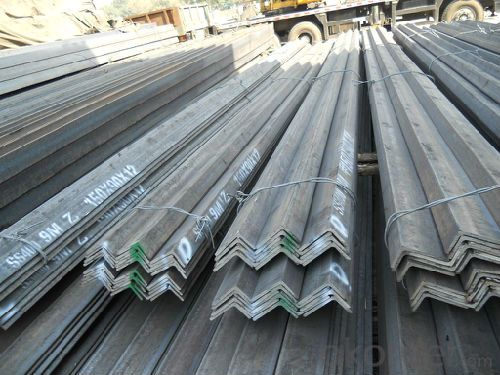
- Q: How are steel angles defined?
- Steel angles are characterized by their shape and dimensions. They consist of L-shaped steel components with two perpendicular legs of either equal or unequal lengths. The angle formed between these legs can vary from 90 to 180 degrees, depending on the specific design and purpose. In construction and engineering projects, steel angles are widely utilized to provide structural support, reinforcement, and stability. To determine their strength, load-bearing capacity, and versatility, the dimensions of steel angles are typically specified in terms of leg length, thickness, and overall length. Due to their diverse applications across various industries, steel angles are available in different finishes, such as galvanized or painted, to enhance their durability and resistance against corrosion.
- Q: How do you determine the required thickness of a steel angle for a specific load?
- To determine the required thickness of a steel angle for a specific load, several factors need to be considered. Firstly, the load that will be applied to the steel angle must be determined. This can be done by analyzing the structural design or the intended purpose of the steel angle. The load can be in the form of a static load, such as the weight of a structure, or a dynamic load, such as the force exerted by moving objects or wind. Once the load is known, the next step is to calculate the bending moment and shear force that will be experienced by the steel angle. The bending moment is the measure of the bending or flexing of the steel angle under the applied load, while the shear force is the measure of the internal forces that act parallel to the cross-sectional area. The bending moment and shear force calculations are typically performed using engineering principles and formulas, such as the moment of inertia and the maximum stress formula. These calculations take into account the dimensions of the steel angle, the applied load, and the properties of the steel material. Once the bending moment and shear force are determined, the required thickness of the steel angle can be calculated. This calculation involves selecting a suitable safety factor, which is used to account for uncertainties and potential variations in the applied load or the strength of the steel material. The safety factor is usually determined by industry standards or codes. The required thickness can then be calculated using the maximum stress formula, which relates the bending moment, shear force, and the dimensions of the steel angle to the stress experienced by the material. By rearranging the formula, the required thickness can be solved for, ensuring that the steel angle is strong enough to resist the applied load without failing or deforming. In summary, determining the required thickness of a steel angle for a specific load involves analyzing the load, calculating the bending moment and shear force, selecting a safety factor, and using the maximum stress formula to solve for the required thickness. It is important to consult engineering principles, codes, and standards to ensure that the steel angle is appropriately sized to withstand the applied load.
- Q: What are the common connections or fasteners used with steel angles?
- Steel angles can be connected or fastened using a variety of methods and materials. Bolts, screws, welds, and rivets are commonly used in this regard. When attaching steel angles to other structural elements or connecting multiple angles together, bolts and screws are often the go-to option. Welding, on the other hand, involves heating and fusing the angles together, resulting in a strong and durable bond. Rivets, which involve inserting a metal pin through holes in the angles and securing them with hammering or mechanical pressing, provide an alternative method of connection. The choice of connection or fastener depends on factors such as the specific application, load requirements, and desired aesthetics.
- Q: Can steel angles be used for ladder rungs?
- Ladder rungs can indeed utilize steel angles, as they boast strength and durability, making them a frequent choice in construction and fabrication. Utilizing steel angles as rungs ensures a solid and secure surface for ladder climbing. Nonetheless, it is crucial to consider the precise requirements and regulations for ladder rungs, including dimensions, spacing, and anti-slip properties. These factors guarantee user safety and ladder stability. It is advisable to consult applicable safety guidelines and standards prior to employing steel angles as ladder rungs.
- Q: Can steel angles be used for electrical conduits?
- No, steel angles cannot be used as electrical conduits. Electrical conduits are typically made of non-metallic materials such as PVC or metal materials such as galvanized steel or aluminum. Steel angles are structural components used for support and reinforcement in construction projects, but they are not designed or suitable for use as electrical conduits. Electrical conduits have specific requirements for insulation, protection, and grounding, which steel angles do not provide. It is important to use proper electrical conduits that meet the necessary safety standards to ensure the integrity and efficiency of electrical installations.
- Q: Can steel angles be used for machine frames?
- Yes, steel angles can be used for machine frames. Steel angles are commonly used in construction and can provide structural support, stability, and durability to machine frames. They offer a strong and rigid framework that can withstand heavy loads and vibrations, making them suitable for various types of machinery.
- Q: Can steel angles be used for stair treads?
- Stair treads can indeed utilize steel angles. Known as angle irons as well, steel angles find frequent application in construction and fabrication due to their robustness and resilience. Acting as stair treads, steel angles furnish a firm base for individuals to ascend or descend the stairs. The inclined form of these steel angles enables superior weight allocation and heightened stability. Furthermore, steel angles can be effortlessly welded or bolted to the stair stringers or supports, rendering them a convenient and dependable selection for stair treads.
- Q: Are steel angles resistant to impact or vibration?
- Steel angles exhibit resistance to both impact and vibration. The strength and toughness of steel make it highly resistant to impact, as it is capable of absorbing and distributing the force generated by an impact, thereby preventing any structural damage. Additionally, steel angles possess a high natural frequency, enabling them to withstand vibrations without experiencing significant deformation or failure. Nevertheless, the resistance of steel angles to impact and vibration may vary depending on factors such as the specific grade and thickness of the steel, as well as the intensity and duration of the impact or vibration. Therefore, it is crucial to carefully consider the specific requirements and conditions of the application when evaluating the suitability of steel angles for impact and vibration resistance.
- Q: Can steel angles be used for agricultural buildings or barns?
- Yes, steel angles can be used for agricultural buildings or barns. Steel angles provide structural support and stability, making them suitable for constructing various components, such as trusses, beams, and frames, in agricultural buildings or barns.
- Q: Are steel angles suitable for high-temperature applications?
- Yes, steel angles are suitable for high-temperature applications. Steel is known for its high strength and durability, and it retains its structural integrity even at elevated temperatures. Additionally, steel angles can withstand thermal expansion and contraction without deformation or failure, making them a reliable choice for high-temperature environments.
Send your message to us
Carbon Steel Unequal Angle with High Quality
- Loading Port:
- China Main Port
- Payment Terms:
- TT or LC
- Min Order Qty:
- 100 m.t.
- Supply Capability:
- 10000 m.t./month
OKorder Service Pledge
OKorder Financial Service
Similar products
Hot products
Hot Searches
Related keywords
